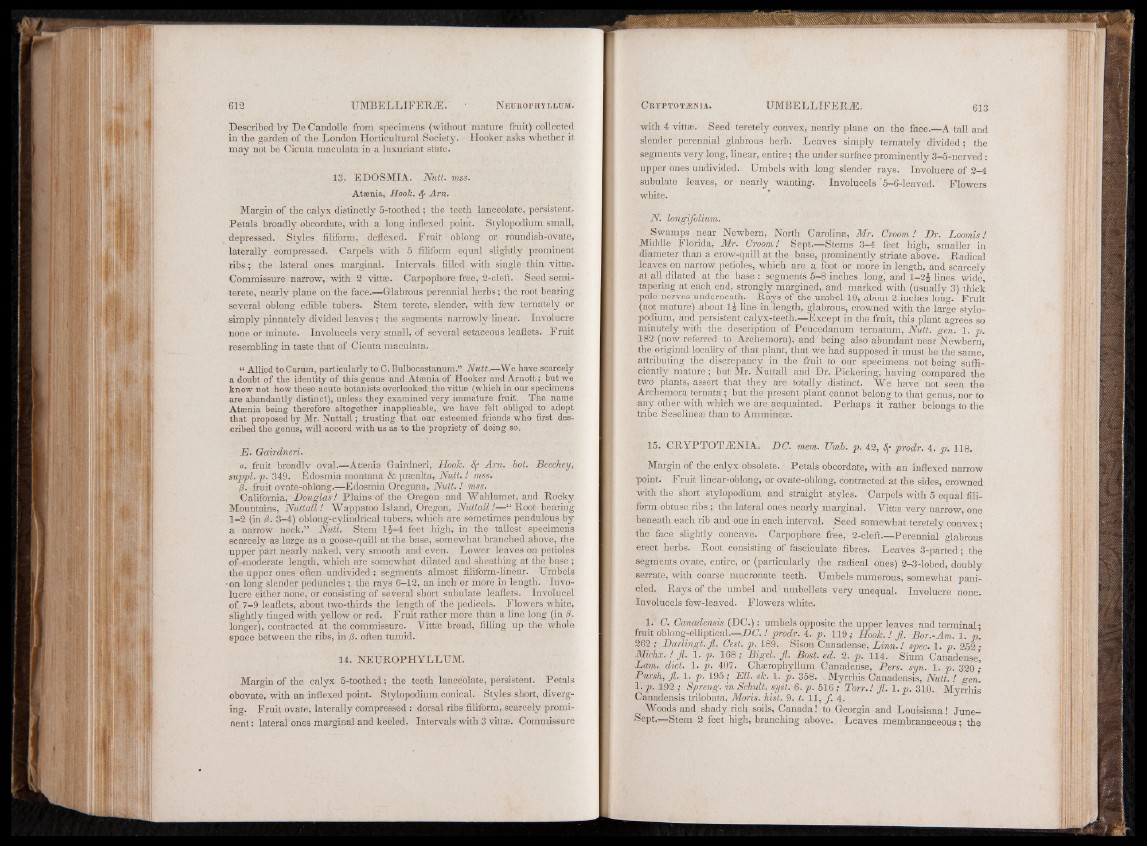
Described by De Candolle from specimens (without mature fruit) collected
in the garden of the London Horticultural Society. Hooker asks whether it
may not be Cicuta maculata in a luxuriant state.
13. EDOSMIA. Nutt. mss.
Atsenia, Hook, cj- Am.
Margin of the calyx distinctly 5-toothed ; the teeth lanceolate, persistent.
Petals broadly obcordate, with a long inflexed point. Stylopodium small,
depressed. Styles filiform, deflexed. Fruit ■ oblong or roundish-Uvate,
laterally compressed. Carpels with 5 filiform equal slightly prominent
ribs ; the'lateral ones marginal. Intervals, filled with single thin vittte.
Commissure narrow, with 2 vittse. Carpophore free, 2-cleft. Seed semi-
terete, nearly plane on the face.—Glabrous perennial herbs; the root bearing
several oblong edible tubers. Stem terete, slender, with few ternately or
simply pinnately divided leaves ; the segments narrowly linear. Involucre
none or minute. Involucels very small, of several setaceous leaflets. Fruit
resembling in taste that of Cicuta maculata.
“ Allied to Carum, particularly to C. Bulbocastanum.” Nutt.—Wo have scarcely
a doubt of the identity of this genus and Atasnia of Hooker and Arnott; but we
know not how these acute botanists overlooked, the vittae (which in our specimens
are abundantly distinct), unless they examined very immature fruit. The name
Atasnia being therefore altogether inapplicable,, we have felt obliged to adopt
that proposed by Mr. Nuttall; trusting that our esteemed friends who first described
the genus, will accord with us as to the propriety of doing so.
E. Gairdneri.
a. fruit broadly oval.—Atsenia Gairdneri, Hoolc. Am. hot. Beechey,
suppl. p. 349. Edosmia montana & praealta, Nu,ft. ! mss.
0. fruit ovate-oblong.—Edosmia Oregana, Nutt. ! mss. .
California, Douglas! Plains of the Oregon and Wahlamef, and Rocky
Mountains, Nuttall! Wappatoo Island, Oregon, Nuttall!—“ Root' bearing
1-2 (in 0. 3-4) oblong-cylindrical tubers, which are sometimes pendulous by
a narrow neck.” .Nutt. Stem l i - 4 feet high, in the tallest specimens
scarcely as large as a goose-quill at the base, somewhat branched above, the
upper part nearly naked, very smooth and even. Lower leaves on petioles
of -moderate length, which are somewhat dilated and sheathing at the base ;
the upper ones often undivided : segments almost filiform-linear. Umbels
•on long slender peduncles the rays 6-12, an inch or more in length. Involucre
either none, or consisting of several short subulate leaflets. Involucel
of 7-9 leaflets, about two-thirds the length of the pedicels. Flowers white,
slightly tinged with yellow or red. Fruit rather more than a line long (in 0.
longer), contracted at the, commissure. Vittse broad, filling Up the whole
space between the ribs, in 0. often tumid.
14. NEUROPHYLLUM.
Margin of the calyx 5-toothed; the teeth lanceolate, persistent. Petals
obovate, with an inflexed point. Stylopodium conical. Styles short, diverging.
Fruit ovate, laterally compressed : dorsal ribs filiform,, scarcely prominent
: lateral ones marginal and keeled. Intervals with 3 vittse. Commissure
with 4 vittæ. Seed teretely convex, nearly plane on the face.—A tall and
slender, perennial glabrous herb. Leaves simply ternately divided; the
segments very long, linear, entire ; the under surface prominently 3-5-nerved :
upper ones undivided. Umbels with long' slender rays. Involucre of 2-4
subulate leaves, or nearly wanting. Involucels'5-6-leaved. Flowers
white.
N. longifolium.
Swamps near Newbern, North Carolina, Mr. Groom ! Dr. Loomis !
Middle Florida, Mr. Groom!' Sept.—Stems 3-4 feet high, smaller in
diameter than a crow-quill at the base, prominently striate above. Radical
leaves on narrow petioles, which are a foot or more in length, and scarcely
at all dilated at the base : segments 5-8 inches long,' and I-2J lines wide,
tapering at each end, strongly margined, and marked with (usually 3) thick
pale nerves underneath. Rays of the umbel 10, about 2 inches long. Fruit
(not mature) about l j line in length, glabrous, crowned with the large stylo-
podium, and persistent calyx-teeth.—Except in the fruit, this plant agrees so
minutely with the description of Peucedanum ternatum, Nutt. gen. 1. p.
182 (now referred to Archemora), and‘being also abundant near Newbern,
the original locality of that plant, that we had, supposed it must be the same,
attributing the discrepancy in the fruit to our specimens not being sufficiently
mature ; but Mr. Nuttall? and Dr. Pickering; having compared the
two plants, assert that they are totally distinct. We have not seen the
Archemora ternata ; but the present plant cannot belong to that genus, nor to
any other with, which we are acquainted. Perhaps it rather belongs to the
tribe Seselineæ than to Ammiheæ.
15. CRYPTOTiENIA. DC. mem. Umb. p. 42, prodr. 4. p. 118.
Margin of the calyx obsolete. Petals obcordate, with an inflexed narrow
point. Fruit linear-oblong, or ovate-oblong, contracted at the sides, crowned
With the short stylopodium and' straight styles'. Carpels with 5 equal filiform
obtuse ribs ; the lateral ones nearly marginal. Vitfle very narrow, one
beneath each rib and one in each interval. Seed somewhat teretely convex;
the face, slightly concave. Carpophore free, 2-cleft.—Perennial glabrous
erect herbs. Root consisting of fasciculate fibres, Leaves 3-parted; the
segments ovate, entire, or (particularly the radical ones) 2-3-lobed, doubly
serrate, with c'oarse mucronate- teeth. Umbels numerous, somewhat pani-
cled. Rays of-the umbel and-umbellets very unequal. Involucre none.
Involucels few-leaved. Flowers white.
1. G. Canadensis (DC.): umbels opposite the upper leaves and terminal;
fruit oblong-elliptical.—DC. ! prodr. 4. p. 119 ; Hoolc. ! fl. Bor.-Am. 1. p.
262 ; Darlingt.fi. Cest. p. 189, Sison Canadense, Linn.! spec. 1. p. 252;
Michx. ! fl. 1. p. 168; Bigel. fl. Bost. ed. 2. p. 114. Sium Canadense’,
Lam. diet. 1. p. 407. Chserophyllum Canadense, Pears, syn. 1. p. 320 ;
Pursh, fl. 1. p. 195; E ll.sk. 1. p. 358. Myrrhis Canadensis, Nutt.! gen.
1 -p. 192 ; Spreng. in Schult. syst. 6. p. 516 ; Torr.! fl. 1. p. 310. Myrrhis
Canadensis trilobata, Moris, hist. 9. t. 11, ƒ. 4.
Woods and shady rich soils, Canada! to Georgia and Louisiana! June-
Sept— Stem 2 feet high, branching above. Leaves membranaceous; the